
La Earthcache / The Earthcache
► Contexte géologique local
Formant un cercle presque parfait, le lac Pavin se situe dans un maar mis en place il y a 6900 ans.
La cuvette de Pavin est principalement remplie des pyroclastes formées lors de l'éruption phréatomagmatisme, mais l'érosion de ces couches superficielles a mis à l'air libre sur les bords du lac des formations géologiques plus anciennes, le système Montchal-Pavin (cône volcanique de trachy-basalte).
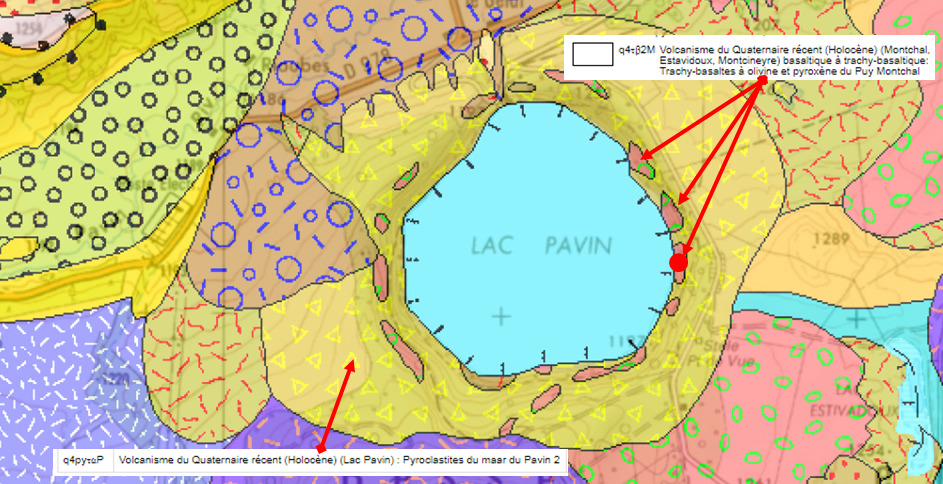
Ainsi, il est possible de découvrir tout autour du lac des saillis de formation basaltique à trachy-basaltique: Trachy-basaltes à olivine et pyroxène du Puy Montchal.
Partons à la découverte de ces formations, et surtout de leur mécanisme d'érosion.
► Le trachy-basalte du Puy Montchal, formation magmatique extrusive
Les trachy-basaltes sont des roches volcaniques de composition intermédiaire entre les trachy-andésites et les basaltes.
Ils se sont formés par cristallisation du magma lors de la remontée rapide de la roche en fusion.
La chute soudaine de pression et de température entre le manteau et la surface a conduit à une cristallisation très rapidement, formant une roche très dure et non grenue (taille de cristal quasi-invisible à l'oeil nu), le trachy-basalte.
C'est une roche mélanocratique avec une structure microlithique holomélanocratique (très sombre).
De couleur principalement bleuâtre, elle présente parfois des colorations plus vertes du fait de la présence d'olivine.
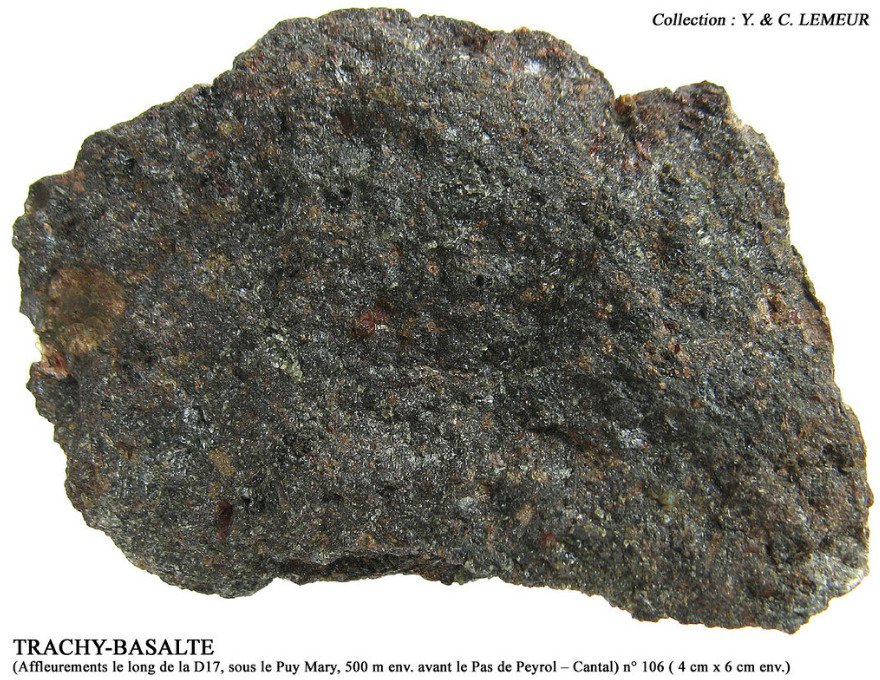
Le trachy-basalte est une roche dure et cohérente, riche en silice et non litée.
Quand elle ne présente pas une structure en prismation (orgues basaltiques), elle subit une forme d'altération particulière commune à toutes les roches silicatées sans structuration interne (sans schistosité, ni joint de stratification…) : diorites, granites,...
On appelle cette altération particulière altération sphéroïdale ou altération en pelures d'oignons
► L'altération sphéroïdale ou altération en pelures d'oignons.
L'intérieur d'un flux de lave trachy-basaltique est constitué d'une superposition de sous-couches, parfois séparées par des accumulations de petites bulles.
Pendant le refroidissement, les "fentes de retrait" (ruptures plus ou moins plates et verticales) et les limites entre les unités d'écoulement (zones de faiblesse plutôt horizontales) ont divisé l'écoulement en blocs à peu près parallélépipédiques.
C'est au niveau de ces zones de faiblesse que des zones de fissures apparaissent, les diaclases.
Elles se présentent comme des fentes quand elles recoupent un flanc de la tranchée et sous la forme de plans bosselés quand elles sont parallèles.
L'eau infiltrée suit tous ces plans et mouille la roche pendant de longues périodes.
Lentement, des processus hydrochimiques altèrent les minéraux ferro-magnésiens (feldspaths et pyroxène) et "pourrissent" la roche.
Les intersections des diaclases (sommets et arêtes des parallélépipèdes) sont les zones les plus touchées, les coins s'arrondissent.
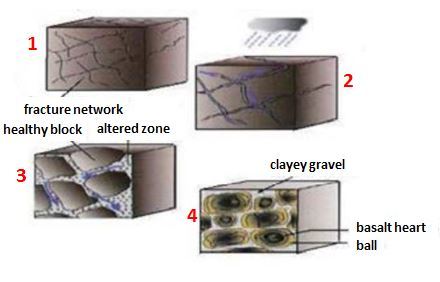
L'altération se poursuit vers le centre des blocs et donne des écailles. Ces blocs s’altèrent en se désagrégeant par couches successives qui se desquament les unes après les autres, donnant un débit en "pelures d’oignons".
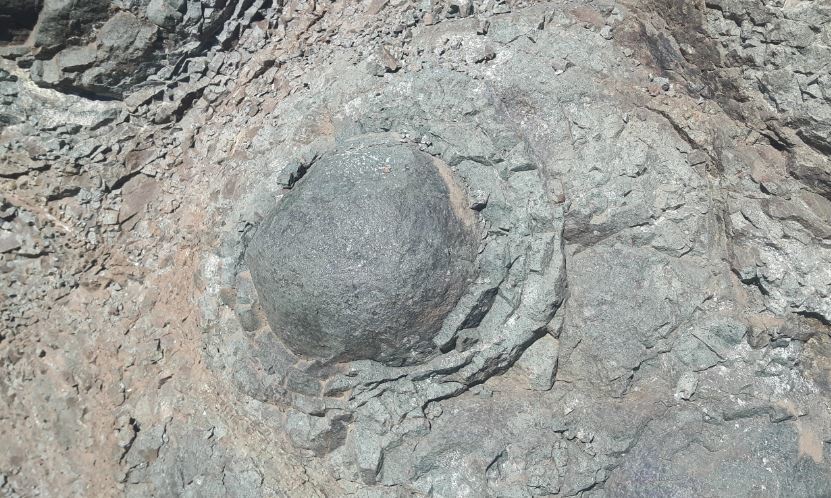
Le processus peut aller jusqu'au détachement complet des boules. Il s'agit d'un processus d'altération long, la mise en place d'une boule complète pouvant prendre plus de 300 000 ans.
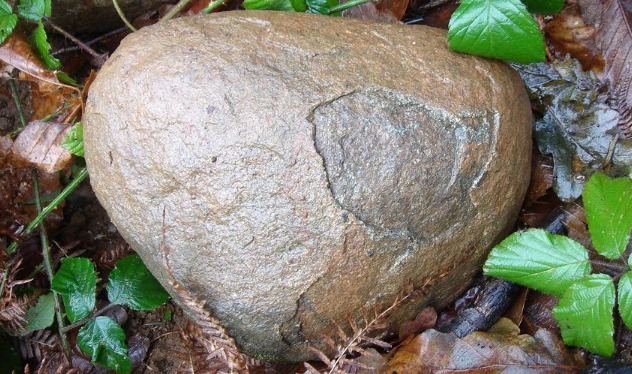
► Local Geological Context
Forming an almost perfect circle, Pavin Lake is located in a maar established 6,900 years ago.
The Pavin basin is mainly filled with pyroclasts formed during the phreatomagmatism eruption, but the erosion of these surface layers has exposed older geological formations, the Montchal-Pavin system (cone) to the air. volcanic trachy-basalt).
Thus, it is possible to discover all around the lake of basaltic to trachy-basaltic projections: Trachy-basalts with olivine and pyroxene from Puy Montchal.
Let's go to the discovery of these formations, and especially of their erosion mechanism.
► Puy Montchal trachy-basalt, extrusive magmatic formation
The trachy-basalts are volcanic rocks of intermediate composition between the trachy-andesites and the basalts.
They were formed by crystallization of magma during the rapid ascent of the molten rock.
The sudden drop in pressure and temperature between the mantle and the surface led to crystallization very quickly, forming a very hard and ungrained rock (crystal size almost invisible to the naked eye), the trachy-basalt.
It is a melanocratic rock with a microlithic holomelanocratic structure (very dark).
Mainly bluish in color, it sometimes has greener colors due to the presence of olivine.
Trachy-basalt is a hard, consistent rock, rich in silica and unread.
When it does not have a prismation structure (basalt organs), it undergoes a particular form of alteration common to all silicate rocks without internal structure (without schistosity, or stratification joint, etc.): diorites, granites, ...
This particular alteration is called spheroidal alteration or alteration in the onion skin.
► Spheroidal alteration or alteration in onion skins.
The interior of a trachy-basaltic lava flow consists of a superposition of sub-layers, sometimes separated by accumulations of small bubbles.
During cooling, the "withdrawal slots" (more or less flat and vertical ruptures) and the limits between the flow units (rather horizontal zones of weakness) divided the flow into roughly parallelepipedic blocks.
It is at the level of these zones of weakness that zones of cracks appear, the diaclases.
They appear as slits when they cut across a side of the trench and in the form of bumpy planes when they are parallel.
The infiltrated water follows all these plans and wets the rock for long periods.
Slowly, hydrochemical processes alter the ferro-magnesian minerals (feldspar and pyroxene) and "rot" the rock.
The intersections of the joints (vertices and edges of the parallelepipeds) are the most affected areas, the corners are rounded.
The weathering continues towards the center of the blocks and gives scales. These blocks deteriorate by disintegrating in successive layers which flake one after the other, giving a flow rate in "onion peels".
The process can go as far as the complete detachment of the balls. It is a long alteration process, the establishment of a complete ball that can take more than 300,000 years.
► Sources bibliographiques / Bibliographical sources
Les Questions / The Questions
La lecture attentive du descriptif de la cache, ainsi qu'une observation des éléments de terrain et un peu de déduction sont normalement suffisants pour répondre aux questions de cette EarthCache.
A careful reading of the description of the cache, as well as observation of terrain features and some deduction is usually sufficient to answer questions of this EarthCache.
Questions pour valider :"Cultures d'Oignons au lac Pavin"
Questions to validate: "Onion crops at Pavin Lake"
- Question 0 : Prenez une photo de vous ou d'un élément vous identifiant avec le Lac Pavin en arrière plan (pas l'affleurement du WP1).
Cette photo devra au choix nous être transmise avec les réponses ou être ajoutée à votre log.
-Question 0 : Take a photo of yourself or an element identifying yourself with Lac Pavin in the background (not the outcrop of WP1).
This photo must either be sent to us with the answers or added to your log.
Dos au lac, nous allons observer deux zones d'affleurement (voir photo WP1_large). Dans un premier temps, allons jusqu'à la zone rouge (zone A).
Go down on the shore at TrailHead 1 and follow the cliff a few hundred meters. At the WP of the EarthCache, you will find at your feet the rock of the photo WP1.

- Question 1 : Décrivez la roche (couleur, texture, taille des grains, dureté). De quelle roche s'agit-il ?
- Question 1 : Describe the rock (color, texture, grain size, hardness). What rock is it?
- Question 2 : Décrivez ce que vous voyez sous les zones vertes à l'intérieur de la zone A visibles sur la photo Zoom_zone_A_rouge. A quoi cela vous fait-il penser ? Nommer cette forme d'altération de la roche.
- Question 2 : Describe what you see under the green areas of the photo WP1_zone_rouge. What does that make you think of? Name this form of weathering of the rock.
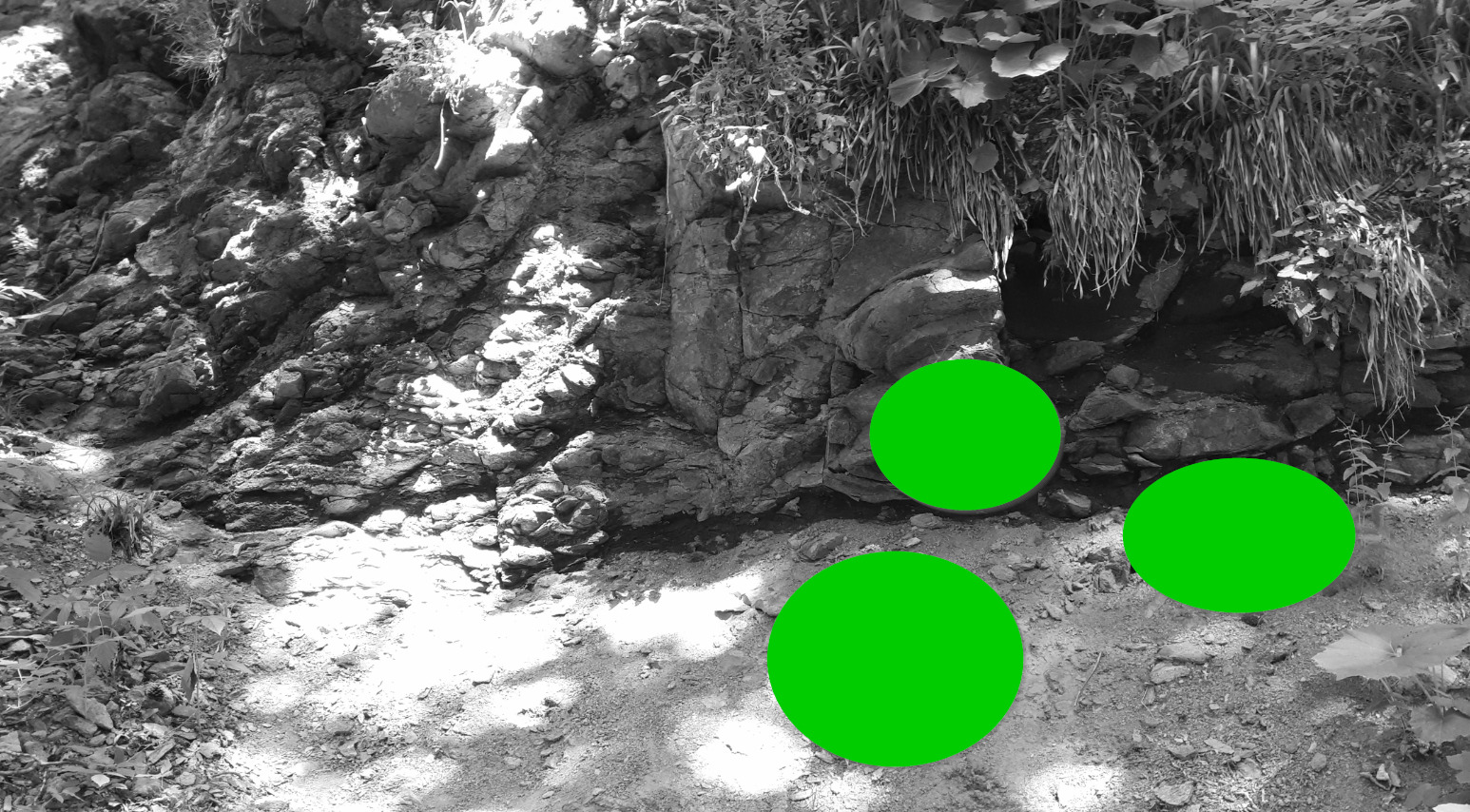
- Question 3 : Décalez vous de quelques mètre sur la droite de l'affleurement et décrivez ce que vous voyez sous la zone bleue B de la photo WP1_large. De quoi s'agit-il ? Combien de temps a t-il fallu pour obtenir cette formation ?
- Question 3 : Shift a few meters to the right of the outcrop and describe what you see under the blue area B of the photo WP1_large. What is it about ? How long did it take to get this formation?
Vous pouvez vous loguer sans attendre notre confirmation,
mais vous devez nous envoyer les réponses en même temps soit par mail via notre profil (
fafahakkai), soit via la messagerie geocaching.com (Message Center).
S'il y a des problèmes avec vos réponses nous vous en ferons part.
Les logs enregistrés sans réponses et la photo seront supprimés.
You can log this cache without waiting for our confirmation, but you must send us the answers at the same time, by e-mail via our profile (fafahakkai) or by the system of Message Center of geocaching.com.
If there is a problem with your answers we will notify you. The logs recorded without answers and the photo will be deleted.
Rappel concernant les « Earthcaches »: Il n'y a pas de conteneur à rechercher ni de logbook à renseigner. Il suffit de se rendre sur les lieux, de répondre aux questions ci-dessus et de nous renvoyer les réponses.
Reminder concerning "Earthcaches": there is neither a container to look for nor a logbook to sign. One need only go to the location, answer to the differents questions and send us the answers.